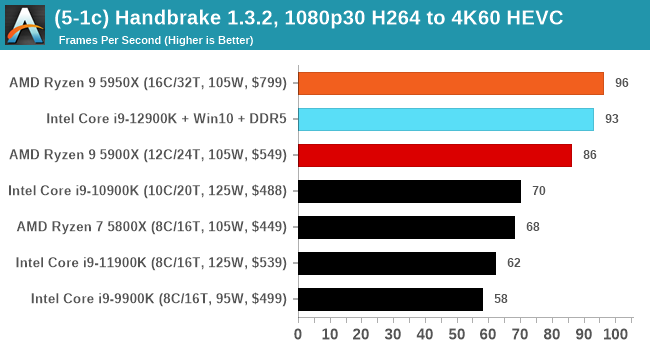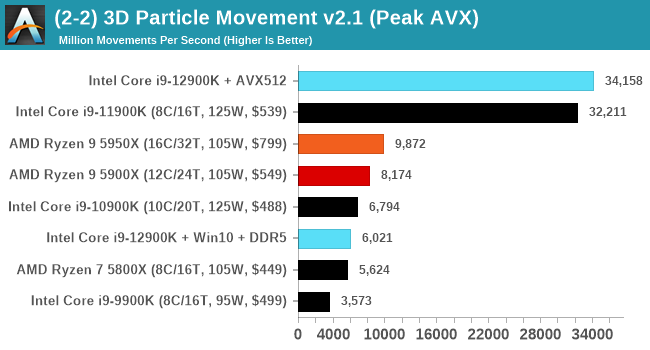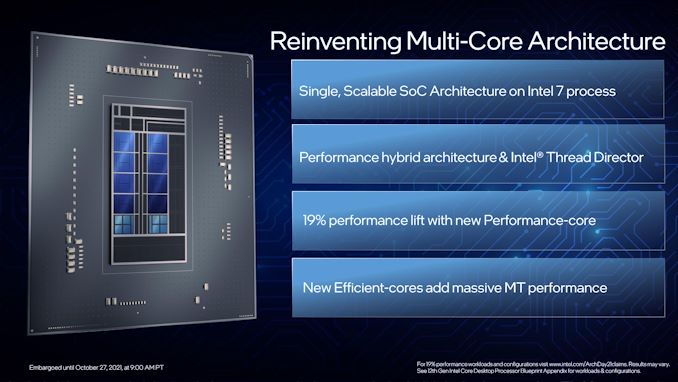The Intel 12th Gen Core i9-12900K Review: Hybrid Performance Brings Hybrid Complexity
by Dr. Ian Cutress & Andrei Frumusanu on November 4, 2021 9:00 AM ESTConclusion: Variables Maketh the CPU
Suffice to say, Intel’s new 12th Generation Core family has added more variables to the mix than a traditional processor launch. The combination of different types of core, coming at a time where a new operating system has just been launched, but also at the inflection point of a new type of memory. Let’s break down some of the differences we’ve observed in our testing.
When we compare Windows 10 to Windows 11, purely on throughput benchmarks, we don’t find much difference. There are a few spots where Windows 11 has a slight advantage in multi-threaded workloads, but this comes down to how new threads are spawned between the performance cores and the efficiency cores. Intel stated that the performance between the two, at least for CPU workloads, should be within a few percentage points, stating that Windows 11 should have lower run-to-run variance. We can corroborate this in our testing. Windows 10 also had some scheduling issues with low priority threads, which we expect to be ironed out with updates.
Comparing the new DDR5 to the old DDR4 is a different story, as the new memory standard offers a substantial uplift when it comes to memory bandwidth. As we saw recently with the M1 Max review, sometimes memory bandwidth can be a limiting factor. In our testing, DDR5 had a minor lead in single threaded tests but in a lot of multithreaded tests, the lead was significant. For real world, we had examples of +14% in Agisoft, +10% in NAMD, +8% in V-Ray, +10% in Handbrake, and +20% in WinRAR. In SPEC2017, we saw a couple of single threaded workloads get +15% improvements over DDR5, but in multi-threaded this was up to +40% on average, or more than 40% in specific tests. This also comes down to the doubled memory channels (4x32-bit vs 2x64-bit) which can be better utilized on top of the bandwidth increases.
Now comparing the P-core to the E-core, and it’s a story of how the E-core individually can perform on par with a Skylake core. Having eight extra Skylake-class cores is nothing to be sniffed at. In a lot of tests the E-core is half the performance of the P-core, but the P-core is itself is now the market leader in performance. The Golden Cove core inside Alder Lake has reclaimed the single-threaded performance crown with an uplift in SPEC of 18-20%, which is in line with Intel’s 19% claim. This puts it ahead of Apple’s M1 Max or 6% (int) and 16% (fp) ahead of AMD’s Zen 3 core.
The Core i9-12900K
Combining fast P-cores, Skylake-class E-cores, and DDR5 into one package means that Intel has certainly jumped from behind the competition to in front of it, or at least in the mix. When you have your operating system set up just right, and no issues with schedulers, it outperforms AMD’s offering when single core performance matters, and in multi-threaded workloads, it does tend to sit somewhere between a 5900X and a 5950X.

It’s important to note that in some tests, the Core i9-12900K does win outright. It’s at this point we should consider how much is core related vs standards related: DDR5 has produced somewhat of an uplift, and the competition is expected to claw some of that back when they introduce it, but those products are expected more towards the latter half of 2022. For users with those specific workloads today, and willing to pay the DDR5 early adopter tax, Alder Lake can provide performance uplifts right now.

Power is an interesting topic, and although our peak power numbers when all cores were loaded were above the 241W Turbo power on the box, in real world workloads it didn’t tend to go that high. The P-cores alone on the chip matched the power consumption of Intel’s 11th Generation in AVX2 workloads, but adding in the E-cores does put it over the previous generation. I’m not entirely sure what that says about Intel’s 7 manufacturing process compared to the 10SF used before. A lot of the performance gains here appear to come from IPC and DDR5, and that doesn’t seem to have come with performance per watt gains on the P-cores. It means that Intel is still losing on power efficiency at load compared to the competition.

I have to say a side word about AVX-512 support, because we found it. If you’re prepared to disable the E-cores, and use specific motherboards, it works. After Intel spent time saying it was fused off, we dug into the story and found it still works for those that need it. It’s going to be interesting to hear how this feature will be discussed by Intel in future.
Overall though, it’s no denying that Intel is now in the thick of it, or if I were to argue, the market leader. The nuances of the hybrid architecture are still nascent, so it will take time to discover where benefits will come, especially when we get to the laptop variants of Alder Lake. At a retail price of around $650, the Core i9-12900K ends up being competitive between the two Ryzen 9 processors, each with their good points. The only serious downside for Intel though is cost of switching to DDR5, and users learning Windows 11. That’s not necessarily on Intel, but it’s a few more hoops than we regularly jump through.











474 Comments
View All Comments
ButIDontWantAUsername - Wednesday, November 10, 2021 - link
How's that validation with Denuvo going? Nothing like upgrading to Intel and having your games suddenly start crashing.Iketh - Tuesday, November 30, 2021 - link
please, no more comments from youtuxRoller - Friday, November 5, 2021 - link
Most desktops at enterprise companies could be replaced with terminals given that most of the people are really just performing data entry & retrieval. The network is the bit doing the work.For people who need old school workstations, then I agree, but that's a damn small (but high margin) market.
blanarahul - Thursday, November 4, 2021 - link
Alder Lake is extremely efficient when gaming - https://www.igorslab.de/en/intel-core-i9-12900kf-c...Scroll down and you'll find a graph detailing total gaming power consumption (CPU + GPU) and CPU power consumed per fps. In both metrics, Alder Lake is doing better than Zen 3 and much better than Rocket Lake.
PC World's review - https://www.pcworld.com/article/548999/12th-gen-co... - conveys that while 12900K goes volcanic in Cinebench, it sips power in a real world workload.
It seems like Alder Lake for desktop has been clocked way beyond its performance/watt sweet spot. It should be very interesting to compare Alder Lake for laptops v/s Zen 3 for laptops.
blanarahul - Thursday, November 4, 2021 - link
To give a short summary for (only) CPU power consumption v/s FPS when playing Horizon Zero Dawn11900K consumes 100 watts for 143 fps
5950X consumes 95 watts for 145 fps
5800X consumes 59 watts for 144 fps
12900K consumes 52 watts for 146 fps
12700K consume 43 (!) watts for 145 fps
Intel is very, very competent with AMD. Considering that 12700K has less E cores and consumes less power, I am very curious how it would do with all E cores disabled and running only on P cores.
Netmsm - Thursday, November 4, 2021 - link
Sounds like there is only gaming world!In PCs it may not be considered as a egregious blunder however you're right Intel is now competitive but to previous AMD's if and only if we wink at Intel's guzzling power.
Some examples from Tom's benches:
y-cruncher
12900k DDR5 consumes 197 watts whereas 5950x consumes 103 watts.
handbrake
12900k DDR5 consumes 224 watts whereas 5950x consumes 124 watts.
blender bmw27
12900k DDR5 consumes 205 watts whereas 5950x consumes 125 watts.
Will you calculate power efficiency, please?
geoxile - Thursday, November 4, 2021 - link
My 5950X uses 130-140W in y-cruncher. And @TweakPC on twitter tested lower PL1 and found the 12900k was only around 5% slower using 150W than 218W. Alderlake being power hungry is only because Intel is pushing 8 P-cores and 8 E-cores (collectively equal to around 4 P-cores according to Intel) to the limit, to compete against 16 Zen 3 cores. You can argue that it's still not as good as the 5950X but efficiency in this case is purely a problem of how much power Intel is allowing by defaultflyingpants265 - Thursday, November 4, 2021 - link
Because they need all that extra power to increase their performance a tiny bit. They're not just doing it for fun.Netmsm - Saturday, November 6, 2021 - link
Exactly 👍Netmsm - Thursday, November 4, 2021 - link
Even Ian has "accidentally" forgotten to put nominal TDP for 12900k in results =))All CPUs in "CUP Benchmark Performance: Intel vs AMD" are mentioned with their nominal TDP except 12900k.
It sounds there's some recommendations! How venal!